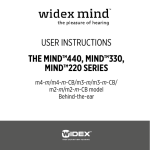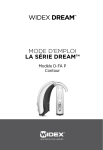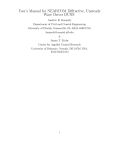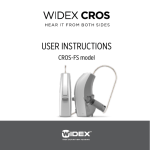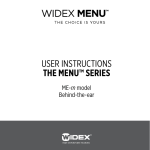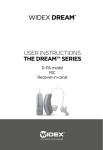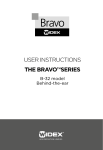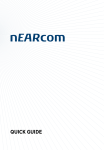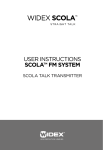Download USER MANUAL WIDEX LINK CONNECTOR
Transcript
USER MANUAL WIDEX LINK CONNECTOR CONTENTS INTRODUCTION . . . . . . . . . . . . . . . . . . . . . . . . . . . . . . . . . . . . . . . . 3 DESCRIPTION OF DEVICE . . . . . . . . . . . . . . . . . . . . . . . . . . . . . . . . 4 Intended use . . . . . . . . . . . . . . . . . . . . . . . . . . . . . . . . . . . . . . . . . . . 5 Indications for use . . . . . . . . . . . . . . . . . . . . . . . . . . . . . . . . . . . . . . 5 THE BATTERY . . . . . . . . . . . . . . . . . . . . . . . . . . . . . . . . . . . . . . . . . . 6 Inserting the battery . . . . . . . . . . . . . . . . . . . . . . . . . . . . . . . . . . . . 6 Changing the battery . . . . . . . . . . . . . . . . . . . . . . . . . . . . . . . . . . . 9 ATTACHING THE WLC TO USB LINK . . . . . . . . . . . . . . . . . . . . . . 11 ATTACHING THE WLC TO NEARCOM . . . . . . . . . . . . . . . . . . . . . 14 TROUBLESHOOTING . . . . . . . . . . . . . . . . . . . . . . . . . . . . . . . . . . . 17 MAINTENANCE . . . . . . . . . . . . . . . . . . . . . . . . . . . . . . . . . . . . . . . . 18 WARNINGS . . . . . . . . . . . . . . . . . . . . . . . . . . . . . . . . . . . . . . . . . . . 19 REGULATORY INFORMATION . . . . . . . . . . . . . . . . . . . . . . . . . . . 21 SYMBOLS . . . . . . . . . . . . . . . . . . . . . . . . . . . . . . . . . . . . . . . . . . . . 23 2 INTRODUCTION These user instructions explain how the Widex Link Connector (WLC) should be used. Please read this booklet carefully before you start using the device. NOTE The WLC may not look exactly as illustrated in this booklet. We also reserve the right to make any changes considered necessary 3 DESCRIPTION OF DEVICE The WLC connects wirelessly to either a USB Link or a nEARcom using a PCB-integrated coil/antenna. Clicking on either the USB Link or nEARcom secures ideal RF connection. The WLC is connected to the hearing aid by a wire with a miniDIN connector and a hearing aid-specific connector. 4 Intended use The WLC is used when fitting a non-wireless hearing aid. It makes it possible to establish a connection between a USB Link or nEARcom and a hearing aid without an RF coil using a miniDIN wire. Indications for use The WLC is to be used by licensed hearing care professionals (audiologists, hearing aid specialists, otolaryngologists) who are trained in hearing (re)habilitation. 5 THE BATTERY The Widex Link Connector uses a Lithium CR2032 battery. Please note the expiration date and the recommendations on the battery pack regarding disposal of used batteries. Inserting the battery Use a screwdriver to remove the screw that holds the cover in place. 6 Be sure to insert the battery as illustrated. The plus (+) sign must face upwards. Screw the cover back on. 7 To check if the battery has enough power to make a complete fitting, press the button next to the battery compartment. If the LED shows a green light, the power level is OK. 1. Button 2. LED 1 8 2 Changing the battery Remove the cover as described under “Inserting the battery”. Insert a flat-head screwdriver between the battery holder and the battery at the point illustrated. 9 Lift the battery, take it out and replace it. Be sure to insert the battery as illustrated. The plus (+) sign must face upwards. Screw the cover back on. 10 ATTACHING THE WLC TO USB LINK Slide the WLC onto the USB Link as illustrated. Make sure it is securely fastened. 11 Plug the programming cables into the corresponding sockets (R = Right, L = Left). The arrows on the programming cables must be upwards, facing the arrows on the WLC. 12 Connect the hearing aids to the programming adaptors as usual. The device is now ready for use. 13 ATTACHING THE WLC TO NEARCOM Remove the cover on top of the neck loop. Insert the WLC connecting piece in the nEARcom neck loop. Attach the WLC to the connecting piece. 14 Plug the programming cables into the corresponding sockets (R = Right, L = Left). The arrows on the programming cables must be upwards, facing the arrows on the WLC. 15 Connect the hearing aids to the programming adaptors as usual. The WLC is now ready for use and the nEARcom neck loop can be snapped onto NOAH link. 16 TROUBLESHOOTING Problem Possible cause Solution Fitting is not possible The WLC battery is exhausted. Press the battery button next to the battery compartment to check whether the battery is working. Change the battery if necessary Programming cables are not correctly connected Check the cables Programming cables are defective Change the cables Note: This information covers only the WLC. See the Widex USB Link user instructions or the nEARcom user manual for information regarding these units. See also the Compass GPS Help System for information on how to connect the hearing aids to the WLC. 17 MAINTENANCE Here are some things you can do to prolong the life of the WLC: WARNING • Do not expose the device to extreme temperatures or high humidity. Do not immerse it in water CAUTION • Clean the device with a soft cloth. Never use acids, alcohol, strong detergents or other liquids. • Avoid dropping the device. • Never try to open or repair the device yourself. (To be performed by authorized personnel only). 18 WARNINGS WARNING Batteries can be dangerous if swallowed or used improperly. Never put a battery in your mouth for any reason as you may risk swallowing it. Swallowing or improper use can result in severe injury, or even fatalities. In case of ingestion, contact your physician immediately. • Keep the device and its parts, accessories and batteries out of reach of children and anyone else who might swallow such items or otherwise cause injury to themselves. Do not change batteries in front of them and do not let them see where you keep your battery supply. • Risk of explosion if battery is replaced by an incorrect type or recharged. CAUTION • Although the WLC has been designed to comply with the most stringent international electromagnetic compatibility standards, the possibility cannot be excluded that it may cause interference with other equipment, such as medical devices. 19 WARNING Interference with active Implants • In order to show caution, we advise to follow the guidelines recommended by manufacturers of defibrillators and pacemakers regarding use of mobile phones: • If you wear an active implantable device keep the Wireless Hearing Aids and Hearing Aid Accessories such as wireless remote controls or communicators at least 15 cm away from the implant. • If you experience any interference, do not use the hearing aids and contact the manufacturer of the implant. Please note that interference can also be caused by power lines, electrostatic discharge, airport metal detectors etc. • If you have an active brain implant, please contact the manufacturer of the implant for risk evaluation. If you have an implantable device, we advise to keep magnets* at least 15 cm away from the implant. (*= can be specified as Autophone magnet, hearing instrument case, magnet in a tool, etc.) 20 REGULATORY INFORMATION Federal Communications Commission Statement Changes or modifications to the equipment not expressly approved by Widex could void the user’s authority to operate the equipment. 21 Electrical and electronic equipment (EEE) contains materials, components and substances that can be hazardous and present a risk to human health and the environment when waste electrical and electronic equipment (WEEE) is not handled correctly. Do not dispose of hearing aids, hearing aid accessories and batteries with ordinary household waste. Hearing aids, batteries and hearing aid accessories should be disposed of at sites intended for waste electrical and electronic equipment, or given to your hearing care professional for safe disposal. Proper disposal helps to protect human health and the environment. 22 SYMBOLS Symbols commonly used by Widex A/S in medical device labelling (labels/IFU/etc .) Symbol Title/Description Manufacturer The product is produced by the manufacturer whose name and address are stated next to the symbol . If appropriate, the date of manufacture may also be stated . Date of manufacture The date when the product was manufactured . Use-by date The date after which the product is not to be used . Batch code The product’s batch code (lot or batch identification) . Catalogue number The product’s catalogue (item) number . Serial number The product’s serial number .* Keep away from sunlight The product must be protected from light sources and/or The product must be kept away from heat 2 23 Symbol Title/Description Keep dry The product must be protected from moisture and/or The product must be kept away from rain Lower limit of temperature The lowest temperature to which the product can be safely exposed . Upper limit of temperature The highest temperature to which the product can be safely exposed . Temperature limits The highest and lowest temperatures to which the product can be safely exposed . Consult instructions for use The user instructions contain important cautionary information (warnings/precautions) and must be read before using the product . Caution/Warning Text marked with a caution/warning symbol must be read before using the product . WEEE mark “Not for general waste” When the product is to be discarded, it must be sent to a designated collection point for recycling and recovery . 324 Symbol Title/Description CE mark The product is in conformity with the requirements set out in European CE marking directives . Alert The product is identified by R&TTE Directive 1999/5/EC as an equipment Class 2 product with some restrictions on use in some CE member states . RCM mark The product complies with electrical safety, EMC and radio spectrum regulatory requirements for products supplied to the Australian or New Zealand market . Interference Electromagnetic interference may occur in the vicinity of the product . *The six- or seven-digit number on the product is the serial number . Serial numbers may not always be preceded by 254 26 27 WIDEX A/S Nymoellevej 6, DK-3540 Lynge, Denmark www.widex.com Manual no.: 9 514 0279 001 #02 Issue: 2014-10 É[5qr0w7|l;;a;s]




























